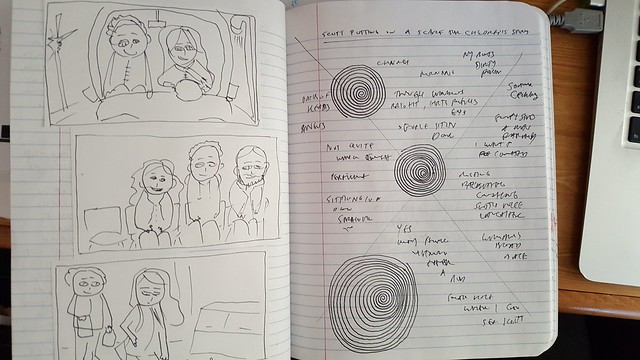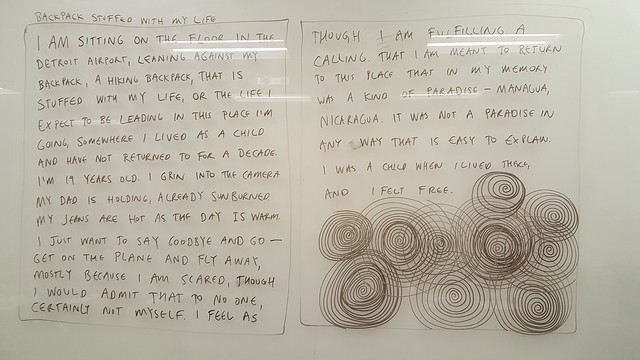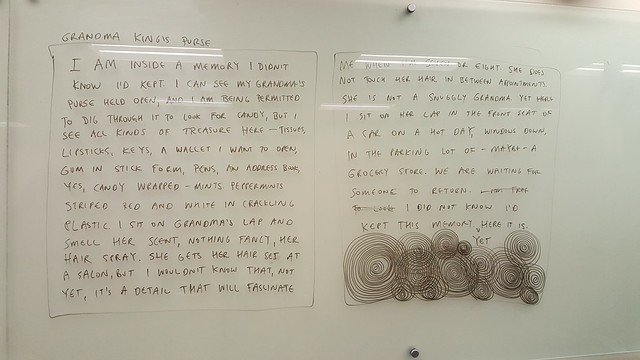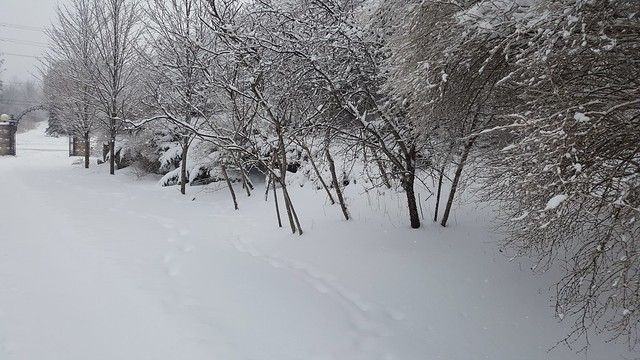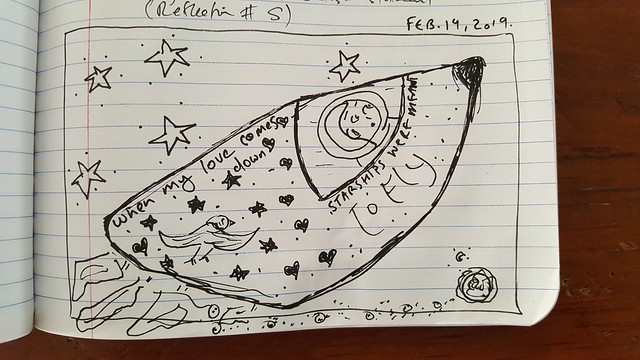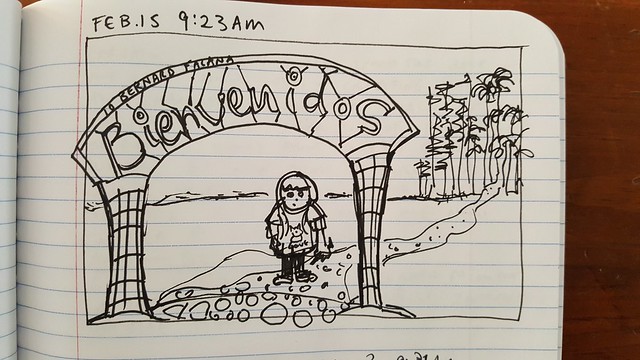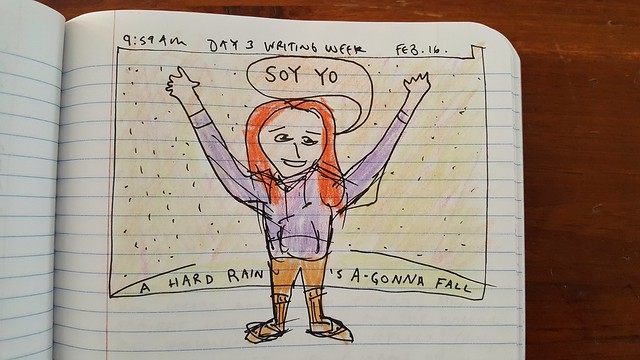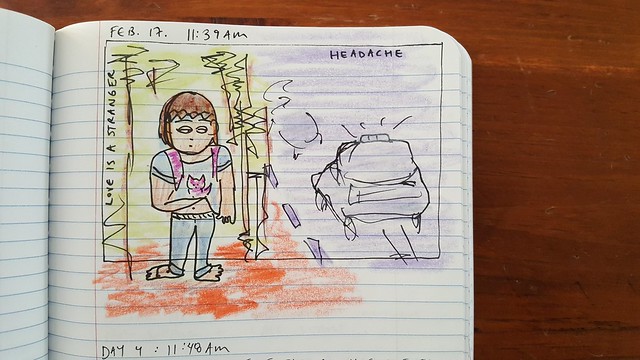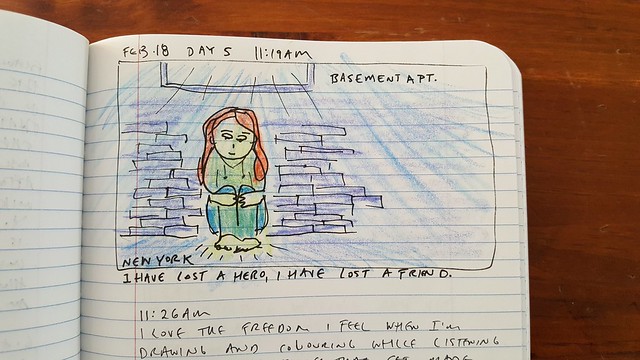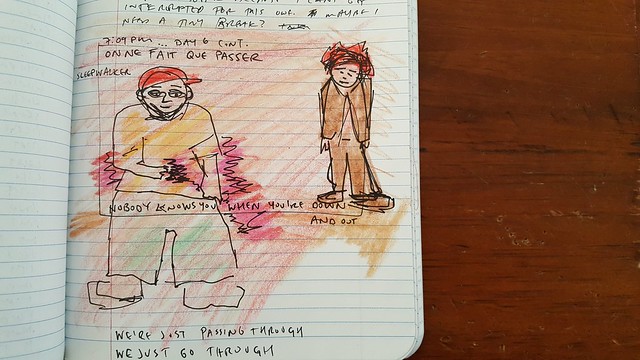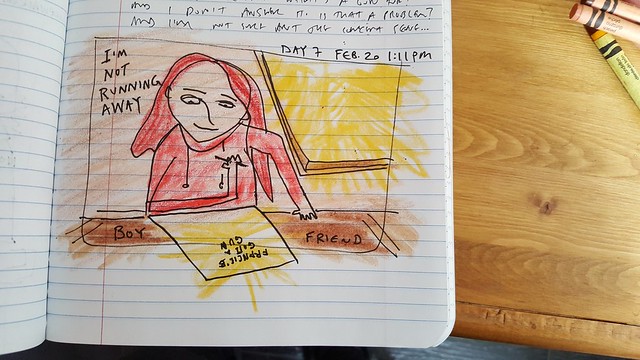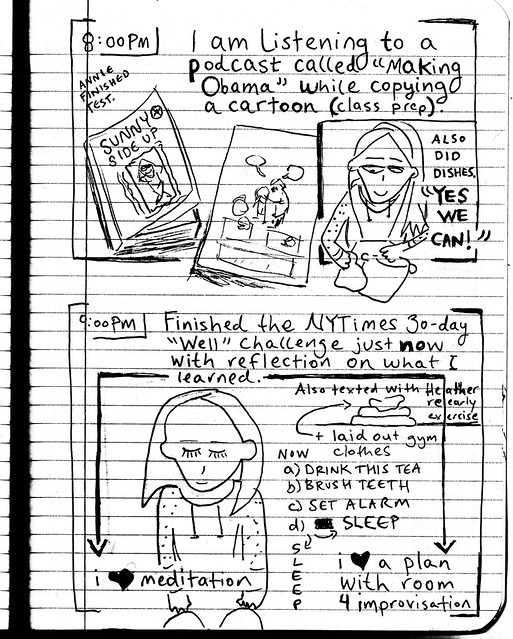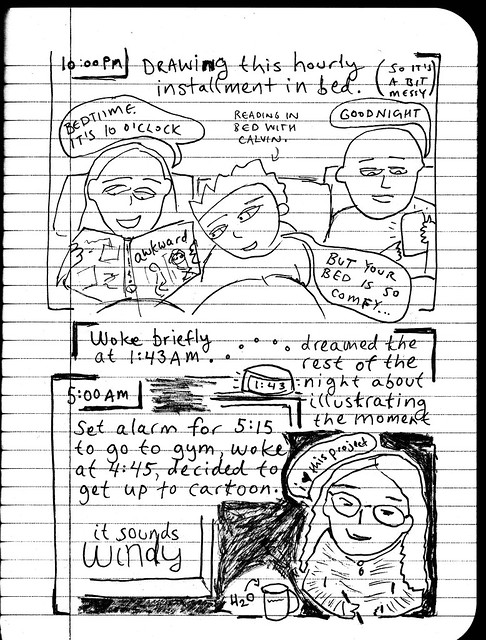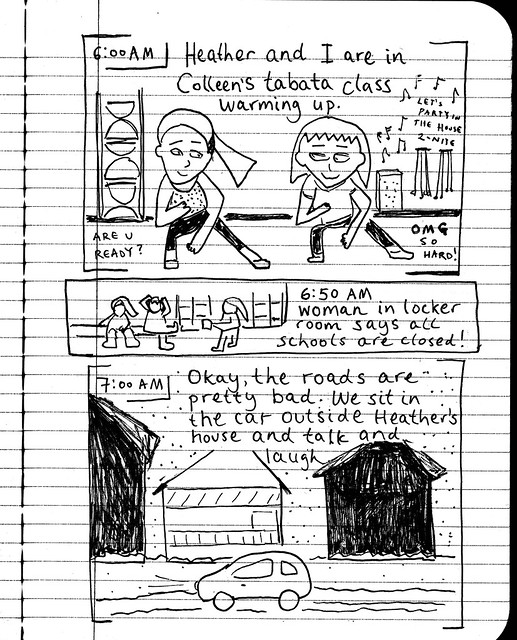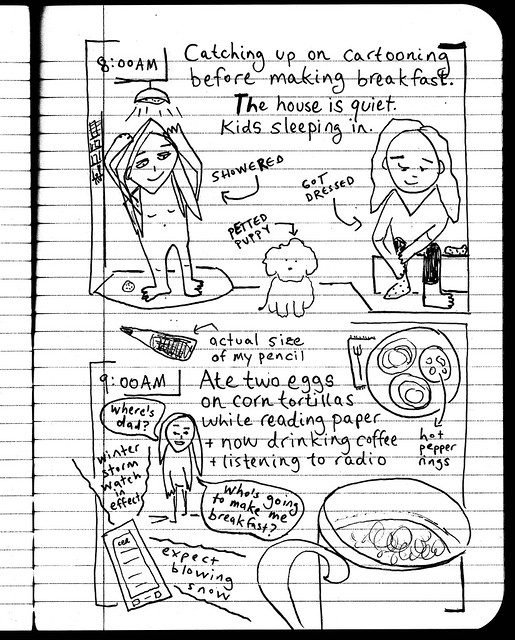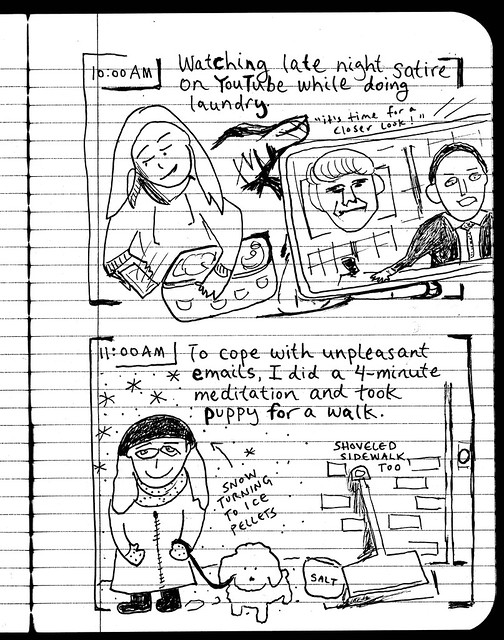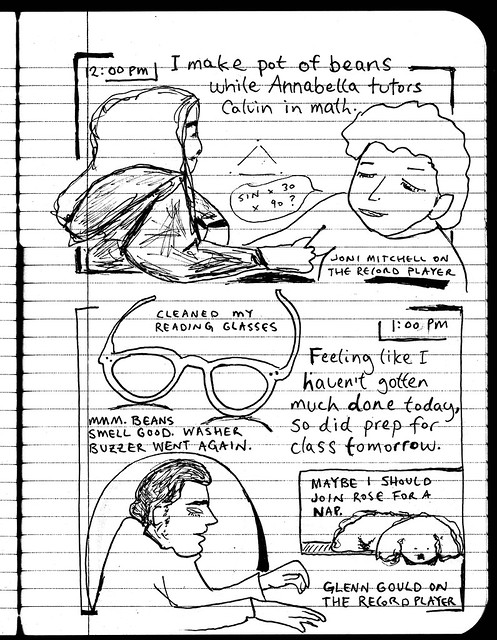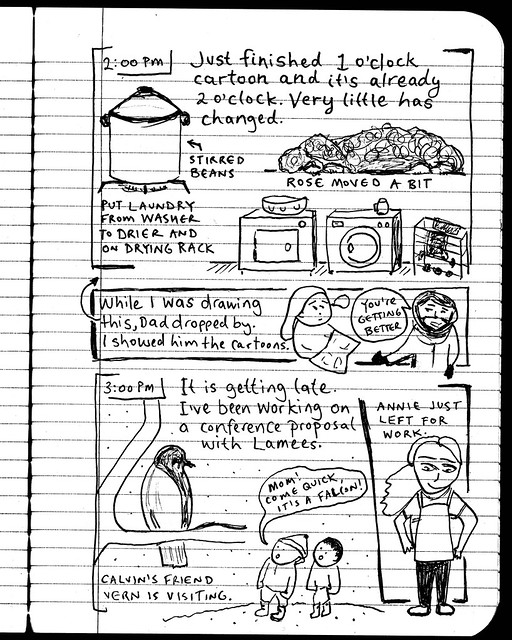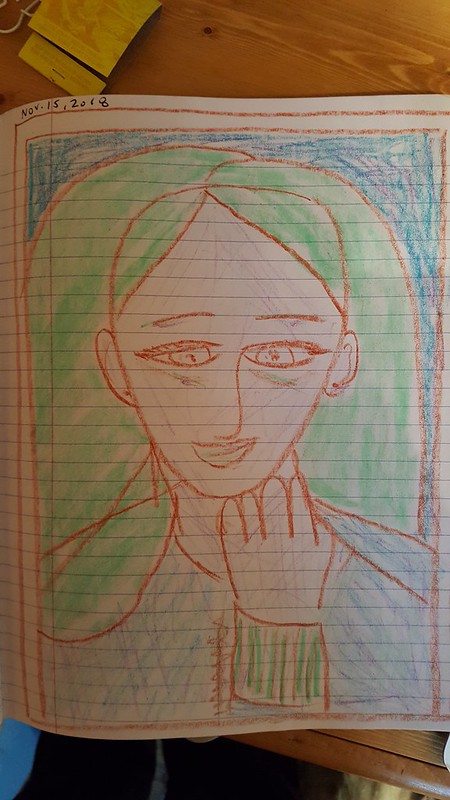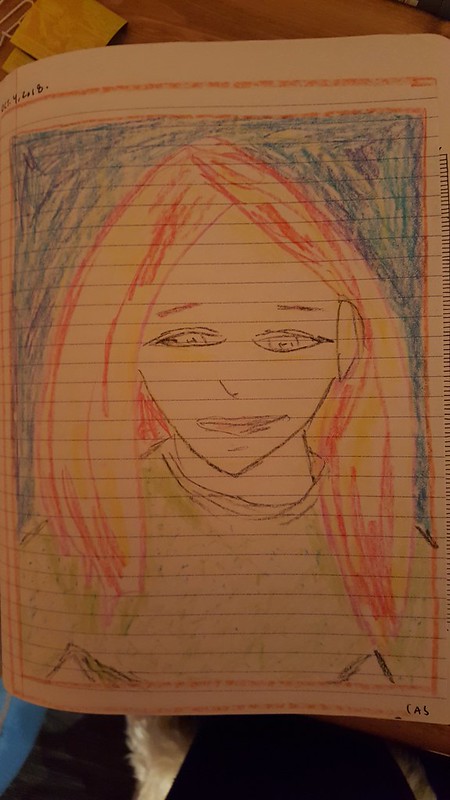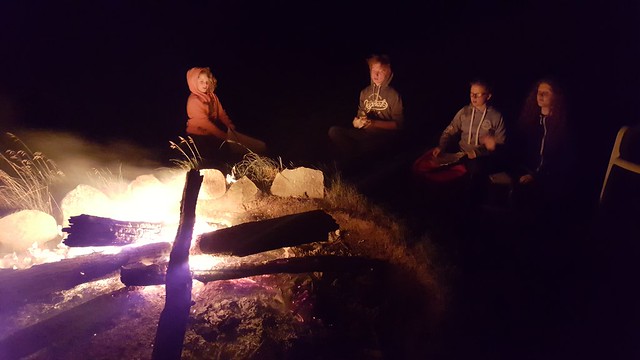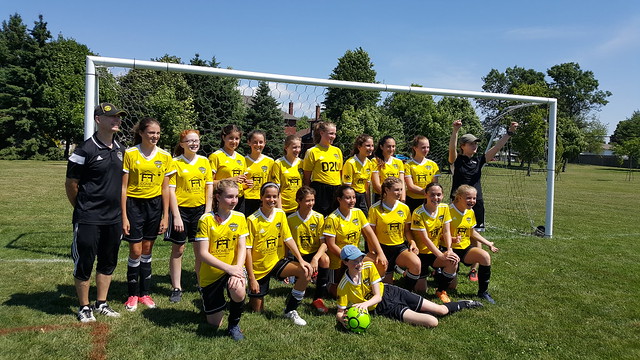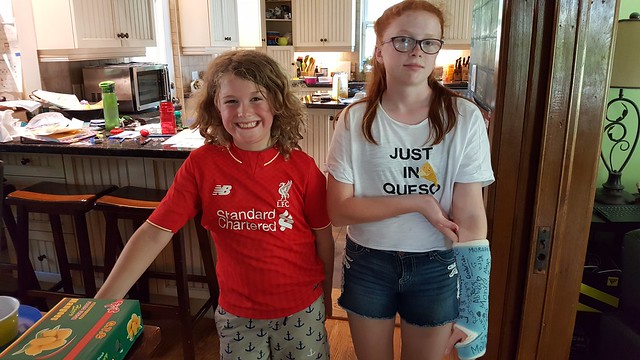Category: Adventure
Thursday, Apr 18, 2019 | Adventure, Art, Big Thoughts, Cartoons, Coaching, Creativity course, Drawing, Fun, Lists, Lynda Barry, Meditation, Peace, Space, Spirit, Teaching, Work |

End-of-term launch party.
I’m done teaching for another term. My course was on the creative process: how to set goals, envision a major project, and lay the groundwork necessary to complete the work. I spent a couple of days this week and last meeting with students to hand back their final projects (stories in comic form), and to chat about the term. Some themes emerged in our conversations. Here’s what we learned.


 The importance of mistakes. So many students talked about how important their mistakes had been in shaping their project, how an apparent mistake had turned out to be important or valuable to their drawing, or how freeing it was to allow themselves to make mistakes. My theory is that through mistakes our unconscious mind gives us important information we couldn’t otherwise access; and drawing is the perfect medium for this communication with the self, because we see our “mistakes” pretty much instantly, and have to figure out what they’re trying to tell us.
The importance of mistakes. So many students talked about how important their mistakes had been in shaping their project, how an apparent mistake had turned out to be important or valuable to their drawing, or how freeing it was to allow themselves to make mistakes. My theory is that through mistakes our unconscious mind gives us important information we couldn’t otherwise access; and drawing is the perfect medium for this communication with the self, because we see our “mistakes” pretty much instantly, and have to figure out what they’re trying to tell us.


 The freedom of stepping away from perfectionism. Students also expressed how freeing it was to embrace their mistakes, or even how freeing it was just to give themselves permission to make mistakes. Creating a major project by hand is time-consuming and laborious, and if you don’t accept the mistakes you’ll inevitably make, you’ll never finish what you’ve started.
The freedom of stepping away from perfectionism. Students also expressed how freeing it was to embrace their mistakes, or even how freeing it was just to give themselves permission to make mistakes. Creating a major project by hand is time-consuming and laborious, and if you don’t accept the mistakes you’ll inevitably make, you’ll never finish what you’ve started.


 The calm that exists inside creation. Every student in the class put a lot of time into their projects, and some put in vast swathes of time, far more than they’d anticipated, or really, that was required to meet the project’s guidelines. (In other words, they didn’t care about the rubric, they cared about the work itself.) Students talked about losing themselves in what they were doing. It didn’t feel like work. It was fun, it was relaxing. The time flew. There is a meditative quality to making things by hand, to being focused in this way; engaged.
The calm that exists inside creation. Every student in the class put a lot of time into their projects, and some put in vast swathes of time, far more than they’d anticipated, or really, that was required to meet the project’s guidelines. (In other words, they didn’t care about the rubric, they cared about the work itself.) Students talked about losing themselves in what they were doing. It didn’t feel like work. It was fun, it was relaxing. The time flew. There is a meditative quality to making things by hand, to being focused in this way; engaged.


 The time for this is always with us. (To paraphrase Lynda Barry.) This feeling of calm, this experience of getting lost inside a pleasurable task, is available anytime. And yet, we seem to need someone to remind us of this, we need a reason to get engaged in this way, a task, a project for a class to give us the excuse to get lost in making something that requires focus and effort, that is time-consuming, and that ultimately may have no material or monetary value. We feel like we have to prove that it’s worth it. I wonder why? When it seems so obvious, looking at these wonderful students and their amazing artwork — their unique, truthful, serious, funny, silly, brave, thoughtful beautiful art — that it is worth it.
The time for this is always with us. (To paraphrase Lynda Barry.) This feeling of calm, this experience of getting lost inside a pleasurable task, is available anytime. And yet, we seem to need someone to remind us of this, we need a reason to get engaged in this way, a task, a project for a class to give us the excuse to get lost in making something that requires focus and effort, that is time-consuming, and that ultimately may have no material or monetary value. We feel like we have to prove that it’s worth it. I wonder why? When it seems so obvious, looking at these wonderful students and their amazing artwork — their unique, truthful, serious, funny, silly, brave, thoughtful beautiful art — that it is worth it.


 This course gave the students permission to make art. To draw. To colour. To turn their lives, their observations, their ideas into cartoons. Many expressed how valuable this practice was for them, and how much they hoped others would get the chance to take the course too. “Everyone should have to take this course!” “You have to teach it again for the sake of future students!” In truth, I’m not sure what I taught was a course so much as a concept: what I tried to do was make space for the students to make space for themselves.
This course gave the students permission to make art. To draw. To colour. To turn their lives, their observations, their ideas into cartoons. Many expressed how valuable this practice was for them, and how much they hoped others would get the chance to take the course too. “Everyone should have to take this course!” “You have to teach it again for the sake of future students!” In truth, I’m not sure what I taught was a course so much as a concept: what I tried to do was make space for the students to make space for themselves.


 Anyone can draw. Most of the students had no idea what they were signing up for when they entered my classroom on day one. They thought they were taking a creative writing course; the course description was vague; they were surprised to learn they’d be doing so much drawing. They weren’t sure they could do it. Many hadn’t drawn since high school, or even grade school. “I never thought I could draw well enough to …” And to a person, they could — they could tell the stories they wanted to tell through cartoons. (“Well enough” went out the window; “well enough” had no place in our classroom.)
Anyone can draw. Most of the students had no idea what they were signing up for when they entered my classroom on day one. They thought they were taking a creative writing course; the course description was vague; they were surprised to learn they’d be doing so much drawing. They weren’t sure they could do it. Many hadn’t drawn since high school, or even grade school. “I never thought I could draw well enough to …” And to a person, they could — they could tell the stories they wanted to tell through cartoons. (“Well enough” went out the window; “well enough” had no place in our classroom.)



 Pride in accomplishment. The final projects undertaken by the students were big!! This was no small undertaking. And everyone did it! The deadline got met, and each project proved to be as unique and individual as the person who created it.
Pride in accomplishment. The final projects undertaken by the students were big!! This was no small undertaking. And everyone did it! The deadline got met, and each project proved to be as unique and individual as the person who created it.
Thank you, Artists of ENGL 332! Thank you for your trust. It was an adventure.
xo, Carrie
Wednesday, Mar 6, 2019 | Adventure, Art, Big Thoughts, Lynda Barry, Space, Spirit, The X Page, Work, Writing |
 If you’ve done any writing workshops with me, you’ll remember the X page, which is a Lynda Barry staple, a page in your notebook on which you draw a big X — you “wreck the page,” as she says — and on this page, you pour out your sensory memories that emerge from whatever image you’re exploring. In the photo below, you can see that blank X mark amidst the text that surrounds it on the board, behind the writer, Tasneem Jamal. This photo was taken yesterday evening, when Tasneem was leading the writing session of The X Page, a writing and theatre workshop for immigrant and refugee women, which I’m coordinating with the help of many wonderful local partners. Last night was our first workshop session!
If you’ve done any writing workshops with me, you’ll remember the X page, which is a Lynda Barry staple, a page in your notebook on which you draw a big X — you “wreck the page,” as she says — and on this page, you pour out your sensory memories that emerge from whatever image you’re exploring. In the photo below, you can see that blank X mark amidst the text that surrounds it on the board, behind the writer, Tasneem Jamal. This photo was taken yesterday evening, when Tasneem was leading the writing session of The X Page, a writing and theatre workshop for immigrant and refugee women, which I’m coordinating with the help of many wonderful local partners. Last night was our first workshop session!
 While the women were writing their stories in their notebooks, I modelled Tasneem’s instructions on the board (those are my X page scribbles). I got to write two new X page stories, which are brief 7-minute recollections based around an image anchored in memory. Our prompt for the evening was “suitcase,” or bag or backpack or purse.
While the women were writing their stories in their notebooks, I modelled Tasneem’s instructions on the board (those are my X page scribbles). I got to write two new X page stories, which are brief 7-minute recollections based around an image anchored in memory. Our prompt for the evening was “suitcase,” or bag or backpack or purse.
 “Backpack stuffed with my life”
“Backpack stuffed with my life”
I am sitting on the floor in the Detroit Airport, leaning against my backpack, a hiking backpack, that is stuffed with my life, or the life I expect to be leading in this place I’m going, somewhere I lived as a child and have not returned to for a decade. I’m 19 years old. I grin into the camera my dad is holding, already sunburned. My jeans are hot, as the day is warm. I just want to say goodbye and go — get on the plane and fly away, mostly because I am scared, though I would admit that to no one, certainly not myself. I feel as though I am fulfilling a calling that I am meant to return to this place that in my memory was a kind of paradise — Managua, Nicaragua. It was not a paradise in any way that is easy to explain. I was a child when I lived there, and I felt free.
 “Grandma King’s purse”
“Grandma King’s purse”
I am inside a memory I didn’t know I’d kept. I can see my grandma’s purse held open, and I am being permitted to dig through it to look for candy, but I see all kinds of treasure here — tissues, lipsticks, keys, a wallet I want to open, gum in stick form, pens, an address books, yes, candy, wrapped; mints. Peppermints striped red and white in crackling plastic. I sit on Grandma’s lap and smell her scent, nothing fancy, her hair spray. She gets her hair set at a salon, but I wouldn’t know that, not yet, it’s a detail that will fascinate me when I’m seven or eight. She does not touch her hair in between appointments. She is not a snuggly grandma. Yet here I sit on her lap in the front seat of a car on a hot day, windows down, in the parking lot of — maybe — a grocery store. We are waiting for someone to return. I did not know I’d kept this memory. Yet here it is.
 Walking home from campus this afternoon, I kept formulating and reformulating my “artist’s statement”; writing an artist statement is something I’ve asked my Creativity Unplugged students to think about doing for our end of term launch party. What would mine be? What would yours be?
Walking home from campus this afternoon, I kept formulating and reformulating my “artist’s statement”; writing an artist statement is something I’ve asked my Creativity Unplugged students to think about doing for our end of term launch party. What would mine be? What would yours be?
Maybe this is my statement:
Life is about seeking beauty: go and find it, record it, and share it.
But I think my statement would also have to include this:
Life is about seeking beauty: go and find it, record it, and share it. We can go together.
xo, Carrie
Wednesday, Feb 20, 2019 | Adventure, Art, Big Thoughts, Cartoons, Confessions, Drawing, Writing |
 I’ve been doing an intensive writing week. I have little transferable advice to pass along regarding strategies for how to write a novel, unless you’re interested in the pathological approach. I’ve spent seven days writing almost non-stop, abandoning all else, and I can report back to you that the overwhelming sensation involved is: compulsion; essentially, it felt too psychologically painful to stop until done. So I wrote till I was done, and the whole book was out of me. (Important side note: Much editing awaits ahead.)
I’ve been doing an intensive writing week. I have little transferable advice to pass along regarding strategies for how to write a novel, unless you’re interested in the pathological approach. I’ve spent seven days writing almost non-stop, abandoning all else, and I can report back to you that the overwhelming sensation involved is: compulsion; essentially, it felt too psychologically painful to stop until done. So I wrote till I was done, and the whole book was out of me. (Important side note: Much editing awaits ahead.)
 I finished this morning. I was working off a previous draft, and an outline, so this wasn’t material conjured from thin air, these are characters I’ve been exploring in one form or another for several years now. I know them. Writing scenes felt like describing events that I’d witnessed. I just had to look around, pay attention, and write what I was seeing.
I finished this morning. I was working off a previous draft, and an outline, so this wasn’t material conjured from thin air, these are characters I’ve been exploring in one form or another for several years now. I know them. Writing scenes felt like describing events that I’d witnessed. I just had to look around, pay attention, and write what I was seeing.
 I marked each writing session by drawing — the drawings I’ve used to illustrate this post — while listening to music (the song titles are incorporated into each drawing). After drawing, I wrote for three minutes — “What’s on your mind?” — the same prompt I use when leading creative writing classes, and it’s brilliant. Just dump it out. And then GO.
I marked each writing session by drawing — the drawings I’ve used to illustrate this post — while listening to music (the song titles are incorporated into each drawing). After drawing, I wrote for three minutes — “What’s on your mind?” — the same prompt I use when leading creative writing classes, and it’s brilliant. Just dump it out. And then GO.
 There must be another way to do this work, of course, and my goal is to give myself enough space during my regular life that I can aspire to write under more regular, ordinary circumstances. Because, I’ll be honest, all I crave is more of this. More and more and more and more. Writing like this feels as natural as breathing. Effortless? In truth, yes. The way that going for a hike in the woods is effortless. Because I was so occupied, it was like I was living in another world. And now, thankfully, that world exists outside of me in a form accessible to others.
There must be another way to do this work, of course, and my goal is to give myself enough space during my regular life that I can aspire to write under more regular, ordinary circumstances. Because, I’ll be honest, all I crave is more of this. More and more and more and more. Writing like this feels as natural as breathing. Effortless? In truth, yes. The way that going for a hike in the woods is effortless. Because I was so occupied, it was like I was living in another world. And now, thankfully, that world exists outside of me in a form accessible to others.
 The relief I feel is extreme. I can’t describe it accurately. I was so afraid that something would happen to prevent me from pouring the whole thing out — the whole story. And to imagine leaving those characters half-formed, half-finished with their tasks, was excruciating.
The relief I feel is extreme. I can’t describe it accurately. I was so afraid that something would happen to prevent me from pouring the whole thing out — the whole story. And to imagine leaving those characters half-formed, half-finished with their tasks, was excruciating.
 I’m writing this now to help myself remember what it feels like to be in this rare place. I want to record what it feels like to be inside this altered state, because I can’t assess it clearly from inside, yet I know I’m not exactly myself, even now. I’m still too attached to that other world, which feels more vital, more marvellous, more enticing than the mundanity of this real world, which is loaded with responsibility, distraction, good intentions (mine) causing problems, irritating details that mustn’t be overlooked. I know it’s good in the real world too, but this other world — it’s like getting to live inside of a novel, which is somehow even more profoundly affecting than simply reading a novel. If you know the pleasure of reading a novel, and falling into that other world (or any invented and stylized world, of any form), I hardly dare tell you that writing a novel is a million times more intoxicating, more absorbing, more wonderful, because that will sound like hyperbole. (Or maybe, too, I fear sounding like a junkie craving another hit.)
I’m writing this now to help myself remember what it feels like to be in this rare place. I want to record what it feels like to be inside this altered state, because I can’t assess it clearly from inside, yet I know I’m not exactly myself, even now. I’m still too attached to that other world, which feels more vital, more marvellous, more enticing than the mundanity of this real world, which is loaded with responsibility, distraction, good intentions (mine) causing problems, irritating details that mustn’t be overlooked. I know it’s good in the real world too, but this other world — it’s like getting to live inside of a novel, which is somehow even more profoundly affecting than simply reading a novel. If you know the pleasure of reading a novel, and falling into that other world (or any invented and stylized world, of any form), I hardly dare tell you that writing a novel is a million times more intoxicating, more absorbing, more wonderful, because that will sound like hyperbole. (Or maybe, too, I fear sounding like a junkie craving another hit.)
 But it’s not hyperbole, it’s true. It’s that wonderful, that absorbing. I must make space to do this — just this.
But it’s not hyperbole, it’s true. It’s that wonderful, that absorbing. I must make space to do this — just this.
 xo, Carrie
xo, Carrie
Wednesday, Feb 13, 2019 | Adventure, Art, Cartoons, Creativity course, Dream, Exercise, Family, Fire, Friends, Fun, Laundry, Lynda Barry, Spirit, Work |










Context: A student introduced me to the Hourlies project, wherein you draw a cartoon marking each waking hour over the course of a 24-hour day. I’m going to assign this as our class’s Reading Week homework. Fortuitously, I decided to test it yesterday/today, on what would become a snow day, and therefore essentially useless to me for other purposes.
Observations: I couldn’t do this project while doing any other project requiring sustained attention. But I’m playing around with ideas for how to do it again — perhaps once a month, or perhaps, when I’ve got time to spare, doing a marathon version over a week; and I’m brainstorming about how to do it as its own standalone project. I really really really did not want to stop today, and in fact made an extra panel (there are two 4:00PMs). I learned a massive amount, which you can see for yourself by comparing the first panel to the last.
Feedback: Welcome, please.
xo, Carrie
Thursday, Nov 15, 2018 | Adventure, Art, Big Thoughts, Cartoons, Confessions, Creativity course, Meditation, Peace, Spirit, Teaching, Work, Writing |

Who will you be in 25 years? This is an exercise I’ve done twice this fall, with different results each time. The first time, I was led through the exercise by someone else. Today, I led my students through the same exercise.
Here’s how to do it, if you want to try:
Draw a self-portrait as if you were posing for an author photo on the back of the book you’ve always dreamed of publishing. Use crayons. If you have a notebook, draw the portrait on the very last page. (10 minutes)
Next, write your author bio blurb. Remember to write in the third person. Cast yourself deep into the future (25 years or so), and discover who you imagine yourself to be. (10 minutes)
Here’s mine, from today. (Note: I draw self-portraits as if I were 25 years younger …)
Carrie Snyder has devoted her life — or the better part of it — to the pursuit of an ideal self that she first imagined into being as a seven-year-old child, when, as a reader of far-ranging taste with a wild imagination she said to herself (and to anyone who would listen): I’m going to do that too! I’m going to write books! While the perfection of her notion would prove impossible to achieve, the truth of its imagery was uncanny (she saw a forest path and a treehouse hideaway, which, as she grew, became representations rather than literal spaces). Through writing, Carrie found herself transported, frequently, into a deeper understanding of her relationship to the world itself and to its many mysteries. She came to a kind of peace with its mysteries, by holding them to the light and examining their facets with care and attention — and love. Love figures heavily in Carrie’s work, specifically in her discipline to craft, and to sharing the joy of a discipline with others. She has not yet finished, and she hopes she never will. What has changed, with time, is her understanding that finishing something is temporary, and that what lasts is the pull of discovery itself. The process. The adventure of it. She will never be satisfied nor think her work on earth complete, and that is the fuel that invites her to continue — to be the ideal self she imagined at age seven: an artist. Someone who by alchemy transforms the ordinary into the extraordinary. Someone who sees what is possible. Someone who looks at the world and loves it with her attention.
Here is the original exercise, completed in October, with a different result (except for the youthful portrait).

Carrie Snyder, despite crippling bouts of self-doubt, has managed to put herself forward, into positions of service, of leadership, roles that demanded the ability to see herself as more powerful and more capable than anyone else did, and by believing, to become. She was not always confident. Was not always the presence she presented. At times, she thought she was doubled, the face to the world not the face she turned to herself. Was it possible to live doubled like this? What did it mean to do work that challenged and frightened her to her very core — could she get up the next day and rise again? But something deep inside ran like an engine or furnace, the flame of desire, the flame of meaning, and she knew she could live in no other way — could she? She tried listening to reason, to her heart, to her spirit, but the fire was the constant that gave her life, renewed her desire to inhabit bodies and minds bigger and braver than her natural own. She said: If I can do it, then I will. She said: Be the change you want to see. And she was. And that was marvellous to her. Because if she could do this, anyone could — anyone loved and believed in and cherished. Carrie Snyder cherishes herself, believes in herself, loves herself and that has made her strong enough to love, believe in and cherish each of you —
each of you —
each of you — beautiful, aching beings
xo, Carrie
PS It’s tempting, when presented with two things, to compare them … but let’s not. I like that both of these projections into the future are, in fact, deeply embedded in the emotional reality of a present moment. Like putting a thumb-tack onto a map to say: I was here.
Wednesday, Jul 11, 2018 | Adventure, Big Thoughts, Coaching, Driving, Family, Fire, Soccer, Stand, Summer, Work |

Oh my goodness, I’m flying off in a million different directions these days. Is this only the second week of summer holidays?? We kicked off our summer with a weekend at my brother and sister-in-law’s farm. The heat was something else. We watched all of the World Cup games, went to the beach, performed the annual burning of the homework, lit some fireworks, chilled around the fire taking turns playing DJ, listening to our favourite songs. It was sweet.
Kevin flew off to Montreal for a couple of days last week.

Then we drove to Kingston for a soccer tournament (that’s me on the end feeling like a champion … and looking somewhat shorter than our team’s tallest players, some of whom aren’t quite 13 yet! Keep growing, girls!). In a bizarre twist, our team actually won all three of our opening games … but did not advance to the semi-finals. I’ve never seen a tournament organized like this, and hope never to see one like it again. The good news is, our team had a blast during the off-hours, plus on the field the girls played like stars, revealing inner grit and resolve and team joy, coming from behind to win each of the games. We had lots to cheer for.

I spent Sunday afternoon driving across Ontario to drop CJ at camp, where he’ll spend the week. It was a very long day, and the air conditioning in my little car DID NOT WORK. (Did I mention how hot it’s been?) Thankfully, I had a driving companion — Angus came along for the ride, and kept us entertained. We spent quite awhile making top 5 lists in the following categories: soups, salads, and sandwiches. Of course, this was over the supper hour when we were barrelling toward camp and not wanting to stop unless absolutely necessary. Discussion of our top 5 sandwiches inspired a long riff on the classic old-fashioned assorted sub. We were so hungry! Angus texted Kevin, who had already arrived home with the girls, requesting he pick us up exactly these sub sandwiches from Pepi’s, a local pizza place that Angus had heard makes good subs. Kevin kindly agreed. Then Kevin texted with the bad news: a hose had burst and the kitchen and basement were flooded.
Eep!
Fortunately, this calamity had only just happened, likely less than half an hour before their arrival home. What could have been a total disaster was just a really messy cleanup (which I wasn’t too terribly sorry to have missed).
The sub sandwiches from Pepi’s were waiting when we got home … very late … The sub was exceptionally tasty. Definitely my # 1 sandwich. Also, the basement was drying out. Also, there were mountains of laundry.

In other news, the kid pictured above got her cast off. (Wrist broken in a soccer game.) But she can’t play for another couple of weeks. She is not loving her role as bench-warmer.

In other other news, I’m working on a potentially BIG project. So is Kevin! (Different projects.) I will share news when/if these projects get off the ground. I feel energized. It’s Marg. Her example was powerful, and I’m lucky to have known her — a woman who used her skills and talents and personality and time here on earth to take charge, take a stand, stand up, speak out, clear and grounded in her intentions and values. Sometimes this means walking toward conflict, rather than away. Difficult decisions, taking responsibility — this is tough stuff for those of us trained to be nice and likeable. I think we need to stop fearing conflict, fearing push-back. Our power is within us, people. I feel it when I run in the mornings. I feel it when I write. I feel it when I reach out to my community. I know what I love, I know what I believe in. I know that the world will always be troubled, there will always be weariness, grief, injustice, greed, unchecked self-interest. I can’t fix that. What I can do is respond to opportunities to be otherwise, to be the change. I remember that I started coaching soccer because I noticed no moms were coaching, and I thought that was weird and a bit sad. Why did the dads get to have all the fun? Then it occurred to me — why was I complaining about it? I could just volunteer and coach! It’s pretty simple, really. If you see something that bothers you, ask yourself: can I change this? If not, can I respond in some other proactive way?
Respond with love, not fear, at every opportunity. That’s the key.
xo, Carrie
Page 10 of 24« First«...89101112...20...»Last » 
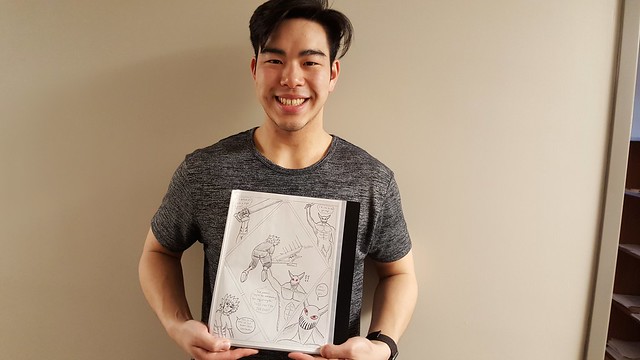
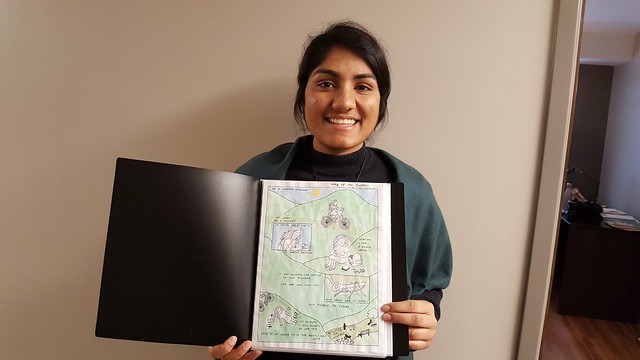 The importance of mistakes. So many students talked about how important their mistakes had been in shaping their project, how an apparent mistake had turned out to be important or valuable to their drawing, or how freeing it was to allow themselves to make mistakes. My theory is that through mistakes our unconscious mind gives us important information we couldn’t otherwise access; and drawing is the perfect medium for this communication with the self, because we see our “mistakes” pretty much instantly, and have to figure out what they’re trying to tell us.
The importance of mistakes. So many students talked about how important their mistakes had been in shaping their project, how an apparent mistake had turned out to be important or valuable to their drawing, or how freeing it was to allow themselves to make mistakes. My theory is that through mistakes our unconscious mind gives us important information we couldn’t otherwise access; and drawing is the perfect medium for this communication with the self, because we see our “mistakes” pretty much instantly, and have to figure out what they’re trying to tell us.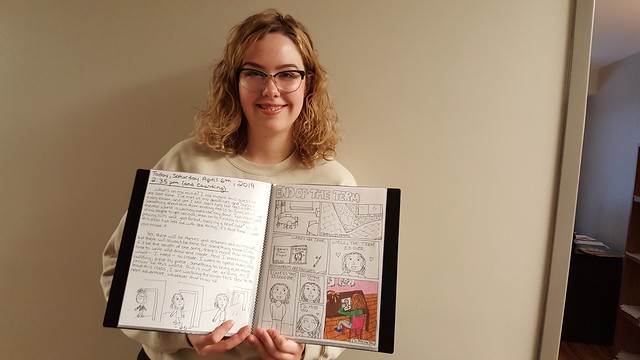

 The freedom of stepping away from perfectionism. Students also expressed how freeing it was to embrace their mistakes, or even how freeing it was just to give themselves permission to make mistakes. Creating a major project by hand is time-consuming and laborious, and if you don’t accept the mistakes you’ll inevitably make, you’ll never finish what you’ve started.
The freedom of stepping away from perfectionism. Students also expressed how freeing it was to embrace their mistakes, or even how freeing it was just to give themselves permission to make mistakes. Creating a major project by hand is time-consuming and laborious, and if you don’t accept the mistakes you’ll inevitably make, you’ll never finish what you’ve started.

 The calm that exists inside creation. Every student in the class put a lot of time into their projects, and some put in vast swathes of time, far more than they’d anticipated, or really, that was required to meet the project’s guidelines. (In other words, they didn’t care about the rubric, they cared about the work itself.) Students talked about losing themselves in what they were doing. It didn’t feel like work. It was fun, it was relaxing. The time flew. There is a meditative quality to making things by hand, to being focused in this way; engaged.
The calm that exists inside creation. Every student in the class put a lot of time into their projects, and some put in vast swathes of time, far more than they’d anticipated, or really, that was required to meet the project’s guidelines. (In other words, they didn’t care about the rubric, they cared about the work itself.) Students talked about losing themselves in what they were doing. It didn’t feel like work. It was fun, it was relaxing. The time flew. There is a meditative quality to making things by hand, to being focused in this way; engaged.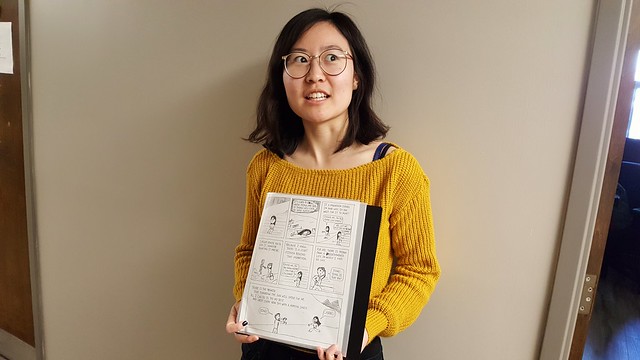

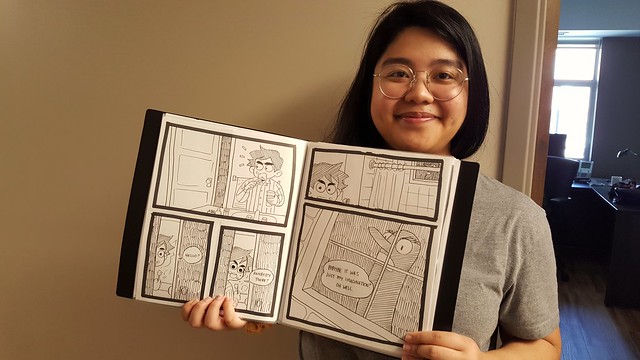 The time for this is always with us. (To paraphrase Lynda Barry.) This feeling of calm, this experience of getting lost inside a pleasurable task, is available anytime. And yet, we seem to need someone to remind us of this, we need a reason to get engaged in this way, a task, a project for a class to give us the excuse to get lost in making something that requires focus and effort, that is time-consuming, and that ultimately may have no material or monetary value. We feel like we have to prove that it’s worth it. I wonder why? When it seems so obvious, looking at these wonderful students and their amazing artwork — their unique, truthful, serious, funny, silly, brave, thoughtful beautiful art — that it is worth it.
The time for this is always with us. (To paraphrase Lynda Barry.) This feeling of calm, this experience of getting lost inside a pleasurable task, is available anytime. And yet, we seem to need someone to remind us of this, we need a reason to get engaged in this way, a task, a project for a class to give us the excuse to get lost in making something that requires focus and effort, that is time-consuming, and that ultimately may have no material or monetary value. We feel like we have to prove that it’s worth it. I wonder why? When it seems so obvious, looking at these wonderful students and their amazing artwork — their unique, truthful, serious, funny, silly, brave, thoughtful beautiful art — that it is worth it.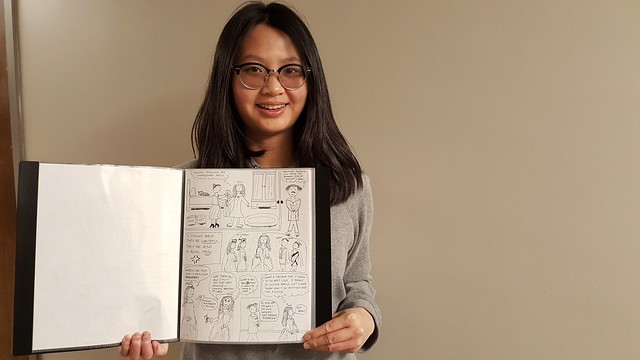

 This course gave the students permission to make art. To draw. To colour. To turn their lives, their observations, their ideas into cartoons. Many expressed how valuable this practice was for them, and how much they hoped others would get the chance to take the course too. “Everyone should have to take this course!” “You have to teach it again for the sake of future students!” In truth, I’m not sure what I taught was a course so much as a concept: what I tried to do was make space for the students to make space for themselves.
This course gave the students permission to make art. To draw. To colour. To turn their lives, their observations, their ideas into cartoons. Many expressed how valuable this practice was for them, and how much they hoped others would get the chance to take the course too. “Everyone should have to take this course!” “You have to teach it again for the sake of future students!” In truth, I’m not sure what I taught was a course so much as a concept: what I tried to do was make space for the students to make space for themselves.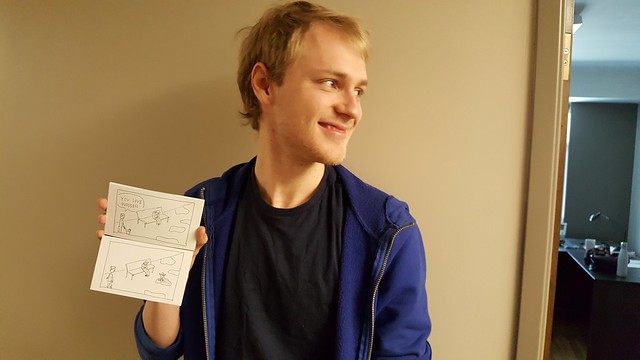
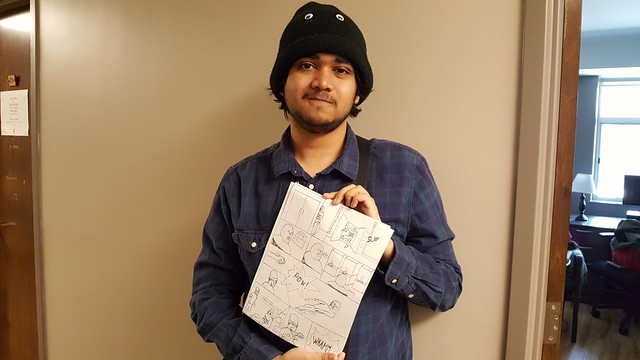
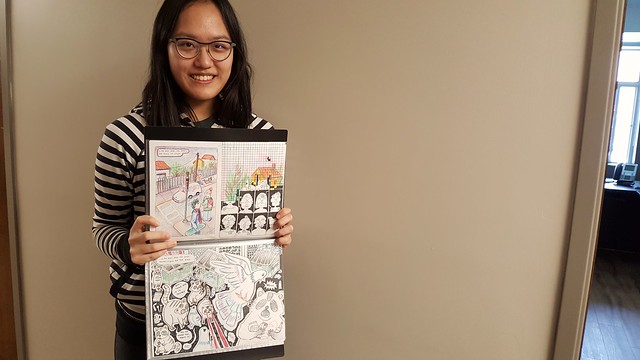 Anyone can draw. Most of the students had no idea what they were signing up for when they entered my classroom on day one. They thought they were taking a creative writing course; the course description was vague; they were surprised to learn they’d be doing so much drawing. They weren’t sure they could do it. Many hadn’t drawn since high school, or even grade school. “I never thought I could draw well enough to …” And to a person, they could — they could tell the stories they wanted to tell through cartoons. (“Well enough” went out the window; “well enough” had no place in our classroom.)
Anyone can draw. Most of the students had no idea what they were signing up for when they entered my classroom on day one. They thought they were taking a creative writing course; the course description was vague; they were surprised to learn they’d be doing so much drawing. They weren’t sure they could do it. Many hadn’t drawn since high school, or even grade school. “I never thought I could draw well enough to …” And to a person, they could — they could tell the stories they wanted to tell through cartoons. (“Well enough” went out the window; “well enough” had no place in our classroom.)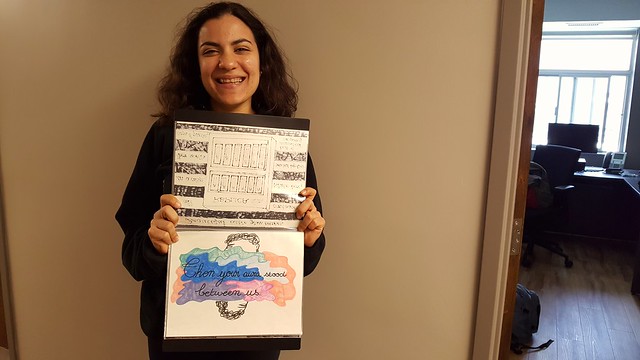


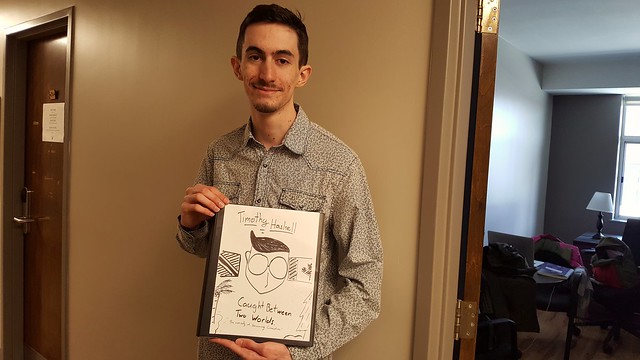 Pride in accomplishment. The final projects undertaken by the students were big!! This was no small undertaking. And everyone did it! The deadline got met, and each project proved to be as unique and individual as the person who created it.
Pride in accomplishment. The final projects undertaken by the students were big!! This was no small undertaking. And everyone did it! The deadline got met, and each project proved to be as unique and individual as the person who created it.

